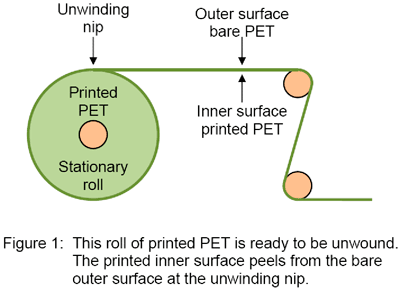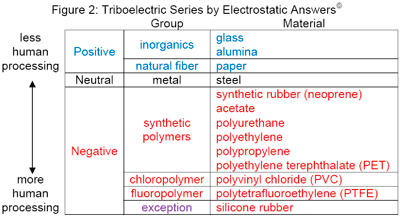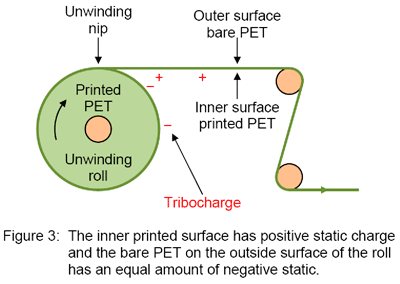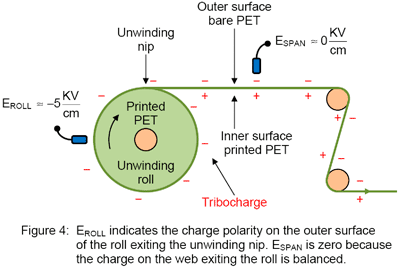Static Beat | Unwinding Roll Tribocharging
- Published: September 19, 2012, By Kelly Robinson
Tribocharging at the unwinding nip can generate high levels of static in a roll-to-roll manufacturing process. This charge can cause a number of problems including attracting airborne contaminants to the unwinding roll, shocking operators, and causing intermittent failures in machine control systems. What measurements can you take to learn if tribocharging is occurring at the nip of an unwinding roll?
To see what is going on, let’s unwind the roll of printed PET web in Figure 1. The roll has been loaded on the unwind spindle and threaded through the first few rollers. To keep things simple, let’s assume that there is no static charge while the roll is stationary.

Printed (or coated) product is commonly wound with the bare side on the outside of the roll to protect the high value printed surface. When unwinding the roll, the printed surface peels from the outer surface at the unwinding nip. When two materials touch and separate, tribocharging occurs. One will have positive charge, and the other will have an equal amount of negative charge. Since the ink (or coating) is chemically different from the bare PET, tribocharging occurs when the ink (or coating) peels from the bar PET at the unwinding nip.
Now, tribocharging is not well understood, and there are almost certainly multiple mechanisms driving tribocharging, like electron transfer, ion transfer, and the breaking of molecular bonds. Until we have better tools, the triboelectric series provides guidance on the polarity and level of tribocharging. Figure 2 shows some of the Triboelectric Series that pertains to web conveyance operations.

To use the Triboelectric Series, find the two materials that touch and separate, such as bare PET and an aluminum conveyance roller. Aluminum oxidizes readily, so the surfaces of aluminum conveyance rollers have a thin (~1 molecule thick) layer of aluminum oxide or alumina. On the triboelectric series, inorganic materials like alumina are near the positive end of the list while synthetic polymers like PET are near the negative end. So, when a PET web touches an aluminum conveyance roller, the PET exits the roller with negative static charge and the aluminum roller has an equal amount of positive charge.
This version of the Triboelectric Series is especially useful because we can use the Group to estimate the locations of materials that are not listed. For example, we do not know the formulation of ink printed on the PET roller in Figure 1. However, many inks have pigments (organic and inorganic molecules), and some coatings have slip agents like silica, so they are likely more positive than PET on the Triboelectric Series.

When the printed roll of PET begins to unwind, the printed surface in Figure 3 will usually have positive static, and the bare PET will have an equal amount of negative static. As the roll continues to unwind, the negative charge on the outside surface of the roll is carried around the roll and exits the unwinding nip in Figure 4 on the outer surface of the PET.

We can use an electrostatic fieldmeter to measure the electric field EROLL near the unwinding roll and ESPAN on the web span exiting the roll. EROLL is moderately negative because the bare PET exits the unwinding nip with negative charge. Do you want to start trade on forex or earn on binary options? It's cool, isn't it? Here is the possibility to do this using no deposit bonus from such forex brokers like FBS, FortFS, Plus500, Instaforex. These brokers are reliable and safe. It's true, that every newbie-trader must to look on withdrawable forex no deposit bonus to start trading with no money, because such way has less risks. It's enough to learn the forex theory, open trading account and start to open deals with bonus capital. No risks, hah? I've already used this possibility. What about you? When are you going to do the same and become the richer? However, ESPAN is nearly zero. The web exits the unwinding roll with positive charge on the inner printed surface of the PET and an equal amount of negative static on the outer bare PET surface. When a fieldmeter reads zero, it is telling you that the charge on the web is balanced … equal and opposite … not necessarily zero.
So, this is the characteristic of tribocharging at the unwinding nip. The fieldmeter reading EROLL taken near the unwinding roll has a moderate magnitude, typically in the range 2 to 5 KV/cm. The polarity indicates the polarity of tribocharging of the outer surface of the roll exiting the unwinding nip. And, the fieldmeter reading ESPAN taken on the web span exiting the roll is nearly zero because the web has positive static on one side and an equal amount of negative static on the other side.
I invite you to ask questions about this column and to suggest future topics. My email address is: This email address is being protected from spambots. You need JavaScript enabled to view it..
Static control expert Dr. Kelly Robinson, president of Electrostatic Answers, has 27+ years of experience in problem-solving and consulting. Contact him at 585-425-8158; This email address is being protected from spambots. You need JavaScript enabled to view it.; www.electrostaticanswers.com.




